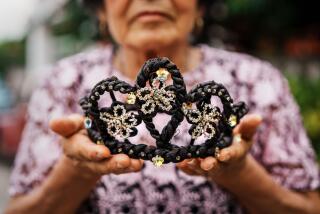Images and Artists : Exhibit Depicts Influence of Virgin of Guadalupe on Mexicans
- Share via
Her influence in Mexican life is pervasive, and it has been since 1531, when she appeared to Juan Diego, an Indian peasant.
According to church accounts, the Virgin made roses bloom in the middle of winter on a rocky hill. Juan Diego, a recent convert to Catholicism who spoke no Spanish, gathered the roses in his robe and took them to Friar Juan de Zumarraga, the first bishop of Mexico.
When the Indian opened his robe, spilling the flowers to the ground, an image of the Virgin appeared on the garment. The bishop fell to his knees before the image, beginning a veneration that now permeates virtually every aspect of Mexican life.
A traveling exhibit of more than 100 examples of the Virgin’s image in Mexican art is showing at the Plaza de la Raza’s Boathouse Gallery. Mexico’s Department of Education and its National Institute of Fine Arts organized the exhibit as part of its Border Cultural Program, which brings art from the country’s interior to both sides of its border with the United States.
“The importance of the Virgin is that her appearance to a native American Indian--and her revealing herself as a dark-skinned person--was the turning point from forced conversions to mass, spontaneous conversions,” said John H. Bowles, exhibitions director at the plaza.
Aztecs identified the Virgin with their goddess Tonantzin, fusing deities from separate religious traditions. Spaniards named her the Virgin of Guadalupe, and she is Mexico’s patron saint, whose image can be found in countless formal paintings, on pendants to protect against the evil eye, on tequila bottle labels.
When the exhibit opened April 18, visitors genuflected and crossed themselves in front of a large portrait of the Virgin flanked by floral arrangements, said Miguel Dominguez, the educational director at the plaza, a Latino cultural and educational center. “They view it not so much as an exhibit, but almost as a shrine,” he said.
Exhibit or shrine, it is an impressive monument to the inventiveness of Mexican artists. Included along with oil on canvas paintings is an intricate portrait of the Virgin done in colored kernels of corn.
Other images are rendered in straw, clay, plaster, bone. “I would eat the meat and throw the bone away,” Dominguez said. “Here’s a folk artist who takes that bone and creates a work that is exhibited internationally.”
One of the most visually striking portraits is done in hummingbird and woodpecker feathers, and one section of the exhibit is devoted to retablos , paintings done on tin and serving as testaments to the Virgin for interceding to rescue people from disasters.
Overcoming Resentment
“People who are not Catholic sort of resented the idea that religious art was coming to the plaza, but when it came, they were just delighted,” Bowles said. “It was so rich and beautiful and integrated with the culture.”
During a visit to Mexico in 1978, Pope John Paul II acknowledged the Virgin’s influence on Mexican culture, saying the country is 90% Catholic but 100% Guadalupano.
“Guadalupe is such a popular name that even men have names like Jose Guadalupe,” said Dominguez. “Almost every Mexican family has a Guadalupe someplace. Lupita, the short form, is very common.”
Some works by Los Angeles photographers have been added to the exhibit to illustrate how the Virgin’s image is also pervasive among Mexican-Americans. Within a few blocks of the plaza, for example, murals depicting the Virgin adorn walls outside a market and in a housing project.
Singing Groups
For the exhibit’s opening, the gallery brought in mariachis who sang cantos Guadalupanos , “almost like love songs to the Virgin,” Dominguez said. So familiar are those songs among Mexicans that the crowd spontaneously began singing along with the mariachis.
Dominguez admitted that he was mildly indifferent when he heard of the exhibit, which continues at the Boathouse Gallery at 3450 N. Mission Road until May 18. After seeing it, though, he found that “it was a study not so much of the Virgin, per se, but of the tremendous amount of artistry there is in Mexico.”
More to Read
Sign up for Essential California
The most important California stories and recommendations in your inbox every morning.
You may occasionally receive promotional content from the Los Angeles Times.













